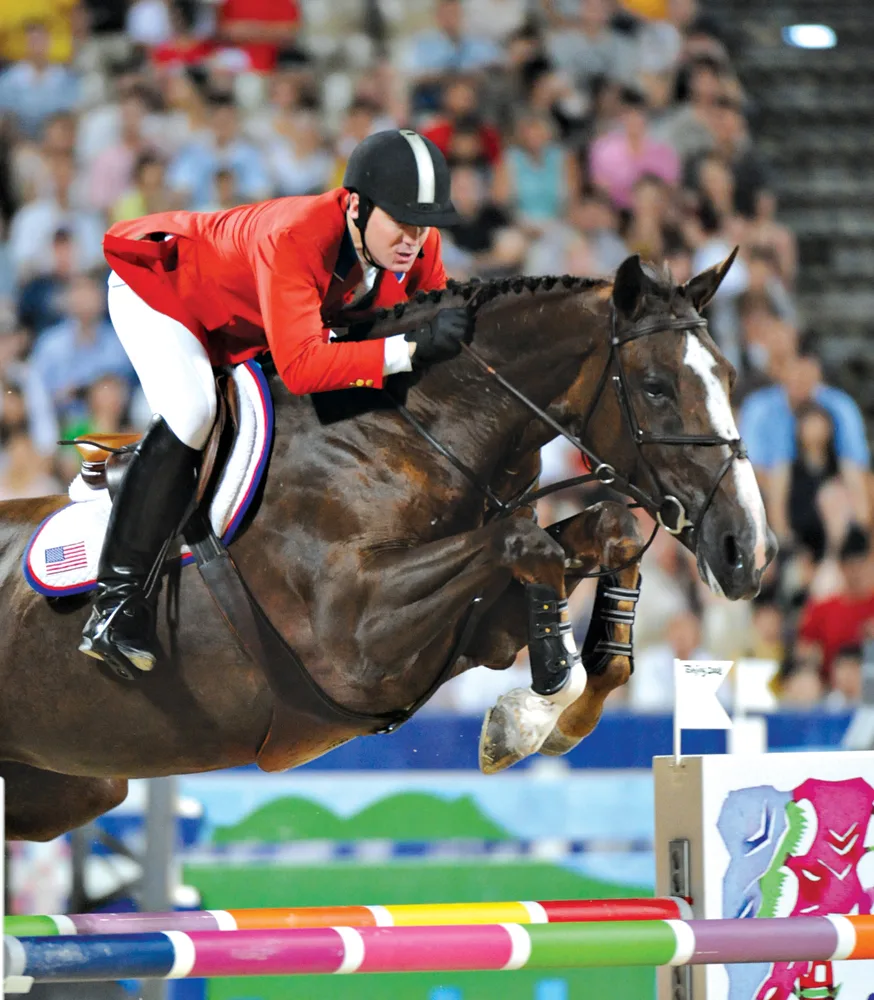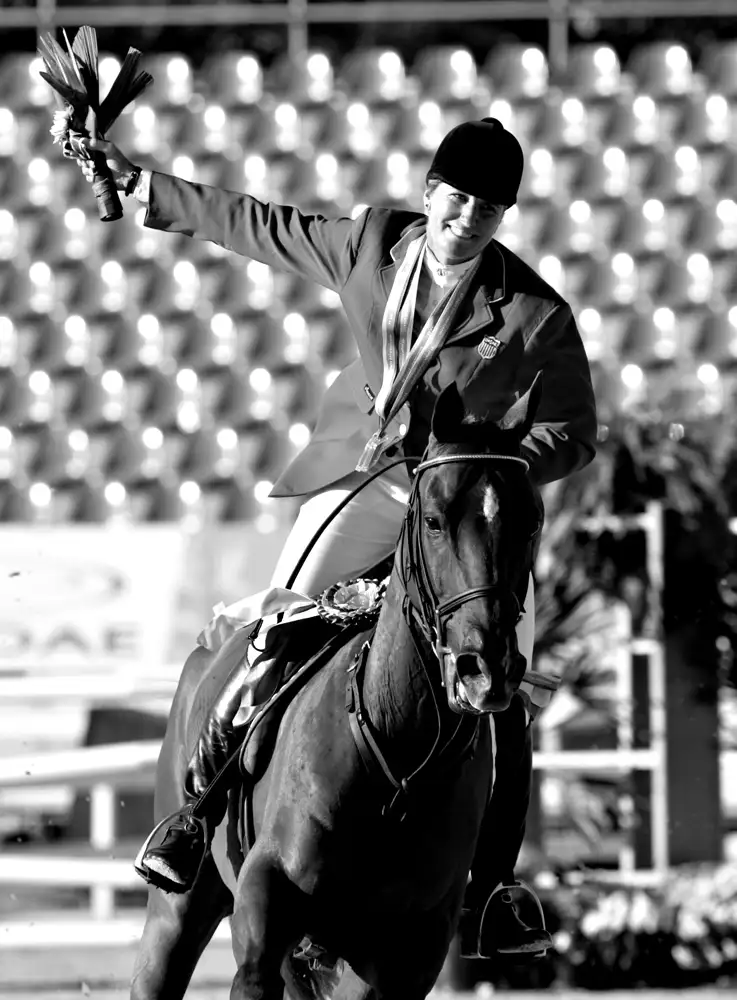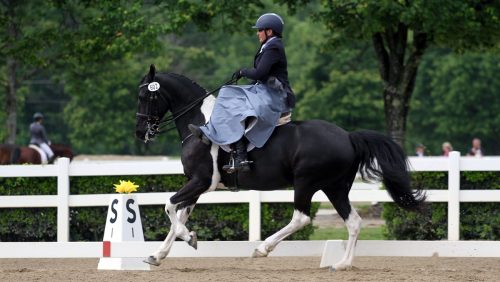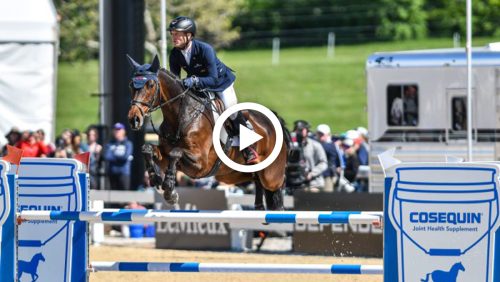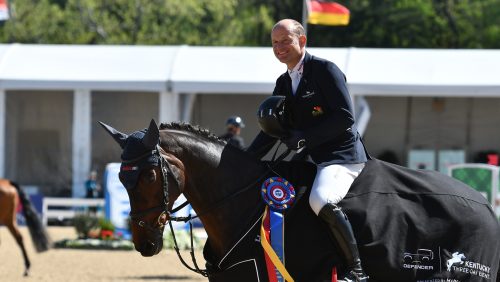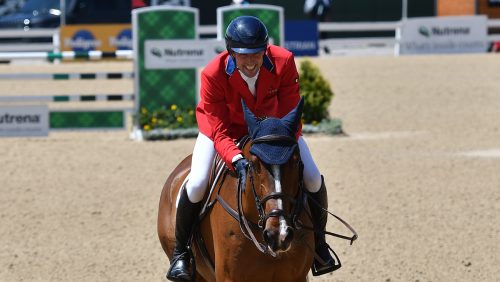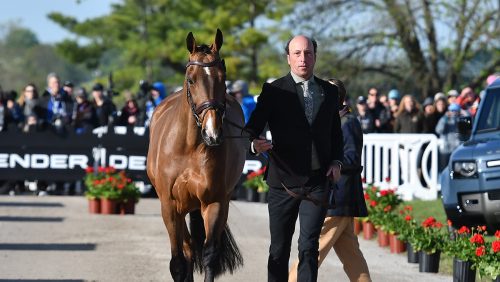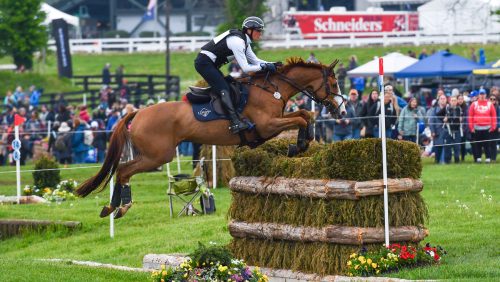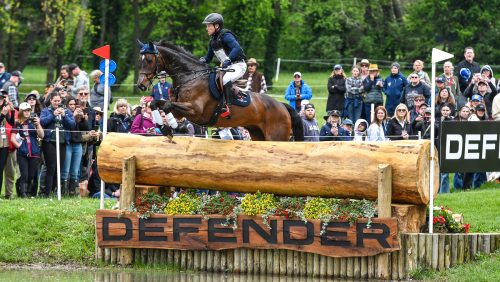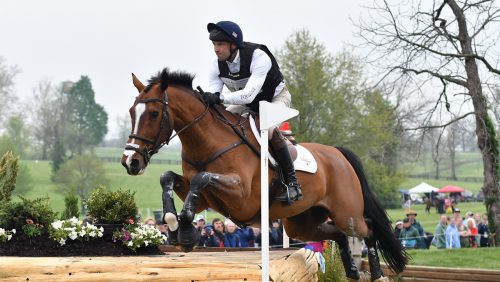The Chronicle of the Horse is celebrating its 85th birthday in 2022. For eight weeks leading up to the publication of our 85th Anniversary Issue, we’re bringing you a decade-by-decade look at the history that has filled its pages since 1937.
At the turn of the century, the horse show world, like much of the rest of the world, looked forward to a new age filled with technological advances and high competition. Although both played a significant role in the equine industry during the first decade of the new millennium, after the midnight glitter settled on Jan. 1, 2000, and everyone realized Y2K was something to be celebrated and not survived, the horse world got back to business.
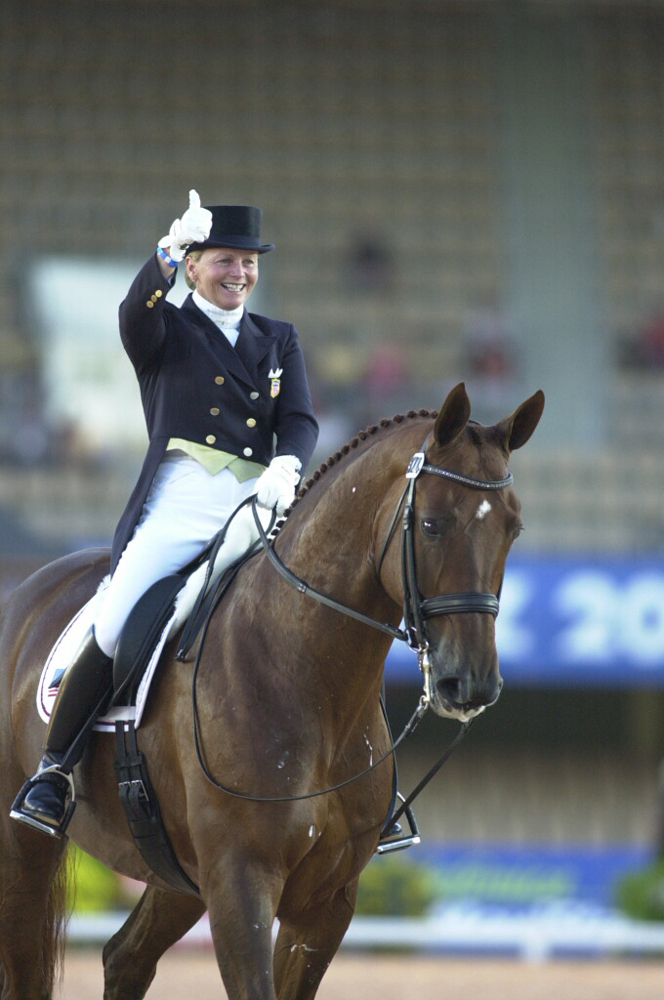
Brentina and Debbie McDonald brought Grand Prix dressage, including their outstanding freestyles, to a new level in the United States in the 2000s. John Strassburger Photo
At the Chronicle, the 2000s brought a variety of changes to both format and staff. In March 2006, Tricia Booker became editor at the magazine when John Strassburger retired, and in 2010 Beth Rasin succeeded Booker. Strassburger continued to write columns for the magazine.
On Sept. 14, 2007, the print magazine went to full color, and for the first time photographs in editorial stories were regularly printed in color instead of black and white.
The Chronicle website grew and evolved into a platform for up-to-the-minute news and daily coverage of events. Instead of waiting a week to read about the latest competition, the 2000s saw a rise in the amount of online coverage from horse shows across the world.
When Tragedy Strikes
After the world was shocked by the Sept. 11, 2001, terrorist attacks in the United States, the horse show world skidded to a stop. Canceled flights and safety concerns prevented international travel, and horse show organizers questioned whether it was disrespectful to hold competitions in the days following 9/11. At the Lincoln American Gold Cup in Devon, Pennsylvania, riders and spectators alike wore red, white and blue ribbons as the show continued.
Four years later, Hurricane Katrina caused severe flooding on the Gulf Coast; animals were abandoned or lost, and food was scarce. However, the equine community jumped to action to send hay and grain to the area, evacuate animals in danger and find new homes for unclaimed pets. On Sept. 9, 2005, a report in the Chronicle described some of the rescue efforts:
… More than 90 horses and mules have been rescued and are now at the Lamar-Dixon Expo Center in Gonzales, Louisiana, where veterinarians and veterinary students from Louisiana State University, and volunteers, have been caring for them.
Among those 90 are 19 carriage horses and mules rescued from New Orleans’ downtown district, where they were used for tourist carriage rides. One brave soul, identified only as Lucian, stayed behind during the hurricane to care for the horses. He and 22 horses rode out Hurricane Katrina. He lost one to a broken neck, but helped 21 survive almost a week with no food, water or supplies. When finally rescued from waist-deep water on Sept. 4, the animals were transported to Baton Rouge, although two did not survive the journey….
This Isn’t Science Fiction
Technological advances in the 2000s allowed competitors to not only submit entries for competitions online but also to see results instantaneously. In 2003, the Upperville Horse Show (Virginia), the oldest horse show in the country, provided results online to celebrate its 150th anniversary and joined more than 420 shows that submitted results electronically to the organization then called USAEquestrian.
In July 2006, scientists began sequencing the horse genome, and on Feb. 7, 2007, the first draft of the horse genome sequence was publicized. Stem cell therapy with adult stem cells as well as embryo stem cells expanded treatment options for ligament or tendon injuries in horses by injecting stem cells directly to the site of the injury.

This horse underwent a study by Dr. Hillary Clayton to define hyperflexion or rollkur. Clayton was a speaker at the FEI forum about the issue in 2006. Photo Courtesy Of Dr. Hillary Clayton
The first cloned horse, a Haflinger filly named Prometea, was born on May 28, 2003, at the Laboratorio di Tecnologie della Riproduzione in Cremona, Italy. Soon after, a Quarter Horse clone was born, and Gemini, the clone of show jumping great Gem Twist, was born Sept. 15, 2008. He was cloned for breeding purposes, and after starting his career at Mary and Frank Chapot’s Chado Farms, he now stands at stud in France, where his get include successful young show jumpers.
Away Hunting Goes Across The Pond
ADVERTISEMENT
During the 2000s, the British hunting community was locked in debate with its government over foxhunting. The argument quickly spilled across the pond, and foxhunters all over the United States voiced their support for their British counterparts’ rights to participate in an ages-old tradition. On March 18, 2001, officers of the Masters of Foxhounds Association of America led members in a “Liberty & Livelihood March” in London. Despite the best efforts of avid foxhunters on both sides of the ocean, Feb. 17, 2005, was the last day to legally foxhunt with traditional methods in Britain. However, the ban didn’t stop enthusiasts from carrying on by laying scent for the hounds to follow. The Chronicle later reported that under the new law, hunts occasionally picked up a scent of a real fox.
“Not only has it been impossible for hunt staff to prevent this from happening, but they’ve also found it difficult to stop a pack of hounds in full cry after their natural quarry. As the hunters’ intention in these cases was to hunt drag and not a fox, it would be difficult for police to achieve a successful prosecution,” wrote Chronicle correspondent Adrian Dangar in the March 25, 2005, issue.

Rumba and John French won the inaugural ASG Software Solutions/USHJA International Hunter Derby Championship in 2009. Tricia Booker Photo
A New Type Of Hunter Class
In 2007, the U.S. Hunter Jumper Association launched its international hunter derby program, which, according to the USHJA, was “created to bring the tradition and art of horsemanship back to the show ring stronger and better than ever,” with the first class hosted in St. Louis, Missouri, in December of that year.
By 2008, international derby classes were popping up on the calendar across the country, with 30 hosted that year, and they continued growing in popularity throughout the rest of the decade. The inaugural $100,000 ASG Software Solutions/USHJA International Hunter Derby was held at the Kentucky Horse Park in August of 2009, and John French rode the gray gelding Rumba to first place.
“I thought it was certainly the most outstanding trip of the class,” said judge Ralph Caristo of the horse’s qualifying round. “From his jumping style to his smoothness, it was just what a hunter should look like. It was a well-ridden and breathtaking round, and as you could see from the scores we all agreed.”
The Event Is The Thing
The 2000s started with a huge victory when the U.S. team won bronze at the Sydney Olympic Games and David O’Connor and Custom Made took the individual gold. The pair was named the Chronicle’s 2000 Overall and Eventing Horse and Horseman of the Year.
The debate between the long and short formats for eventing competitions raged throughout the 2000s. In 2004, Rolex Kentucky included long and short format options so that riders could prepare for the new short-format Athens Olympic Games. In 2006, the Kentucky, Badminton (England) and Burghley (England) four-stars transitioned to the short format to prepare for the FEI World Equestrian Games in Aachen, Germany. Although the organizers of the Kentucky event originally planned to go back to the long format in 2007, it never happened.
At the end of 2006, Phillip Dutton started riding for the United States instead of his birth country of Australia, just in time to help the team sweep the 2007 Pan American Games in Rio de Janeiro. Also on that team, Karen O’Connor and her pint-sized mount Theodore O’Connor earned the individual gold medal.

Karen O’Connor and Theodore O’Connor helped the U.S. team bring home gold and snatched an individual gold of their own at the 2007 Pan American Games in Rio de Janeiro. Cealy Tetley Photos
Dressage Dreams
Dressage superstars Debbie McDonald and Brentina launched to international dressage greatness in the 2002 World Equestrian Games in Jerez, Spain, when they helped the U.S. team earn silver. Individually, they placed second in the Grand Prix Special and fourth in the freestyle.
At the 2003 FEI Dressage World Cup Final they placed second behind Rusty and Ulla Salzgeber, but when Rusty tested for a higher-than-threshold level of testosterone, Brentina and McDonald became the first American team to win the title.
“I really feel for Ulla—I really do,” she told the Chronicle for a Nov. 28, 2003, article. “I can’t imagine what she’s going through right now… Realistically, Rusty was the real winner on that day; he had the better test. So it’s a bittersweet way to win.”
The rise in popularity of dressage freestyles prompted discussion about how to best judge the freestyle. Between Rounds columns frequently asked how to make judging fair, how to maintain amateur interest and debated the best ways to promote the relatively young sport in the United States.
ADVERTISEMENT
A darker side of dressage also was discussed frequently throughout the later 2000s. Hyperflexion, or “rollkur,” brought accusations and defense of a method of training still deemed controversial. In July 2005, St. Georg, a leading German equestrian magazine, accused Dutch riders of using training methods that compromised the welfare of their horses by bending their necks behind the vertical. While the riders defended their training methods, the Fédération Equestre Internationale concluded after a workshop held in January 2006 that there was no scientific evidence proving that hyperflexion by an experienced rider harmed the horse. The report noted that with an inexperienced rider, the horse might suffer physical repercussions.
Medications And Rule Changes
At the 2004 Athens Olympics, four horses tested positive for medication, which resulted in lengthy hearings. Cian O’Connor and Waterford Crystal of Ireland were stripped of their individual gold medal, and the German show jumping team lost their gold after Ludger Beerbaum’s mount, Goldfever, tested positive. After the medals were readjusted—the U.S. show jumping team earned gold, and Chris Kappler earned individual silver—the FEI and the renamed U.S. Equestrian Federation took a harder look at drug and medication rules.

The U.S. show jumping team earned the gold medal 18 months after the end of the 2004 Olympic Games in Athens. From left, McLain Ward, Beezie Madden, Chris Kappler and Peter Wylde wore their gold medals on Feb. 5, 2006, in a special ceremony during the Gold Coast Jumper Classic in Wellington, Fla. Bob Langrish Photo
The FEI began classifying different drugs as either legal or illegal with threshold amounts for each substance. The USEF also took measures to discourage drugs, as John Strassburger noted in a commentary on Jan. 28, 2005:
The trick with any drug rule is that the testing and the penalties have to discourage people from using more exotic drugs to make lame horses sound or hot horses quiet. That’s why they’re always improving their techniques at the USEF laboratory in Ithaca, New York. And it means that the penalties for people who misuse the drug rule have to be stiff enough to deter others from calculating that the price of getting caught is less than the reward of winning a class or selling an unsound or inappropriate horse to an unsuspecting buyer.
Strassburger went on to describe the USEF’s approach of classifying and researching drugs and organizing a penalty system that would increase punishments severely.
The controversy surrounding the 2004 Olympics was repeated in 2008 when four horses tested positive for capsaicin, a pain-reliever derived from chili pepper plants that can make horses’ legs more sensitive. Two additional horses, including Courtney King-Dye’s mount Mythilus, tested positive for other banned substances. Due to the FEI’s then-policy of zero tolerance, King-Dye and the U.S. team were disqualified. In a Sept. 26, 2006, Chronicle report, King-Dye said, “They have to punish me according to the FEI rulebook because I can’t prove where the drug came from. I can’t prove it because I don’t know. I can’t place blame or resentment anywhere.”
In 2009, the FEI changed its classification of some drugs and allowed therapeutic medications at competitions. Despite the rule changes, the debate over various drugs and their use at competitions continues to this day.
Helmet Safety
Helmet debates raged during the first decade of the new millennium. As of Dec. 1, 2001, juniors were required to wear ASTM/SEI-certified helmets in hunter, jumper and hunt seat equitation classes. The Chronicle even provided a certified helmet guide for junior riders.
Trainers, riders, judges and parents debated the availability of properly fitting helmets, the need for discipline-specific helmets and the need of rule enforcement.
Later, in 2005, the USEF passed a rule that all riders, no matter their age, in hunter, jumper and equitation classes needed to wear ASTM/SEI-approved helmets. According to a Chronicle report on Jan. 28, “This rule sailed through with barely a whimper… Convention veterans shook their heads in relief, remembering the passionate opposition to a junior helmet rule proposed 15 years ago, passion that was still evident when the current junior helmet rule passed three years ago.”
Bringing WEG To The United States
The Kentucky Horse Park in Lexington tried to bring the 2006 World Equestrian Games out of Europe and to the United States, but Aachen, Germany won the bid. However, for the 2010 Games, only France and the United Arab Emirates opposed Kentucky’s bid. In a May 13, 2005, report by the Chronicle, John Nicholson, executive director at the horse park, said, “Everyone [at the Fédération Equestre Internationale] I’ve talked to seemed to be rooting for the Games to come to Kentucky, with the exception of the French, who were courteous.”
When the FEI picked Lexington as the site for the 2010 WEG, not only was it the first time the games were held In North America but Alltech also became the first title sponsor of the competition.
Read about all the decades of the Chronicle: the 1930s and 1940s | the 1950s | the 1960s | the 1970s | the 1980s | the 1990s | the 2000s



